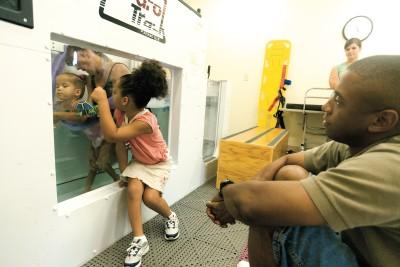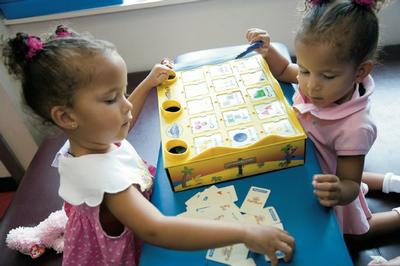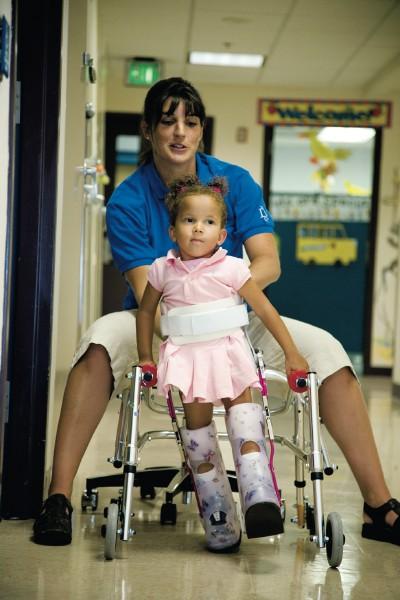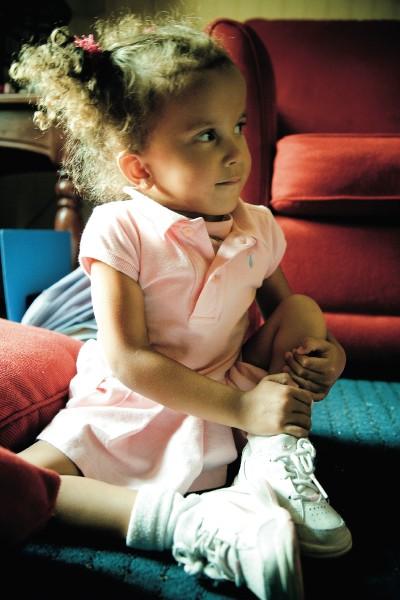A little toy named Fishy keeps Erin busy as a physical therapist holds onto her knees, guiding her fragile legs under the water. A purple foam water toy helps keep Erin’s 23-pound frame standing.
She cried the first time she got into the Hydro Track, a tank with a treadmill at the bottom that can be used for people with spinal-cord injuries. Now she’s getting used to it.
“Last time she took ten steps on her own,” her mother, Melissa, says.
When Erin exercises in the water, she doesn’t have to fight gravity, so she can do things she otherwise couldn’t. Her therapist, Amy, puts her legs in motion but sometimes loosens her hand and feels Erin’s hip flexors take over.
Erin has never known what it’s like to walk. She and her twin sister, Jade, were born attached—about one in 200,000 live births is a set of conjoined twins—and her heart was inside Jade’s chest. The same surgery that separated them as babies left Erin paralyzed from her midchest down.
Erin is old enough to understand that if she works hard in therapy, often four hours a day, she might get to stop using her wheelchair. She rides 4.2 miles on an electrical-stimulation bike while watching Scooby Doo. One time she fell asleep while three people were helping her walk.
But she’s still three years old.
“Daddy,” she once asked, “can you fix my legs, please?”
Whenever Melissa Buckles opens her cell phone, she sees a photo of Erin and Jade from when they were a few months old, joined from chest to navel.
“I can’t bring myself to change it,” she says. “It’s a reminder of where we’ve been—how far we’ve come.”
When Melissa handed her twins to an anesthesiologist at Children’s Hospital more than three years ago, there was a chance neither would survive. She calls her daughters “miracle girls.”

Melissa and her husband, Kevin, always celebrate the June anniversary of Erin and Jade’s separation surgery. This year they were at Kennedy Krieger Institute in Baltimore, where Erin gets therapy. It hit them for the first time: The anniversary of the separation is also the anniversary of Erin’s injury.
“We were rejoicing that day,” Kevin says of the surgery. Nobody had any idea Erin was paralyzed.
Soon after the twins’ separation, they noticed Jade was moving her legs and Erin wasn’t. A lack of blood flow to the spine during surgery, which doctors can’t explain, had likely caused a stroke to her spinal cord.
When The Washingtonian published a story about the Buckles family in February 2006, Erin and Jade were turning two. Erin was using her red car and her “scooter,” a crawling frame that fit her body, because she was too small for a wheelchair. When she saw Jade and their older sister, Taylor, running around, she’d say, “Run, run, run,” and start crawling.
Melissa and Kevin had seen occasional movement in Erin’s legs, but doctors said it was probably reflexes. Erin was working with a physical therapist at home in Stafford. Doctors weren’t pushing for anything more intensive. A neurologist had told Kevin and Melissa that Erin would never regain function below the level of her injury—too much time had passed.
“We were told, ‘Six months to a year after the injury—that’s your best chance of recovery. Anything you’re going to get will be within that time frame,’ ” says Melissa. “That’s what we were fighting against.”
A former high-school teacher, Melissa was reading Christopher Reeve’s Nothing Is Impossible: Reflections on a New Life and put the book down when she got to the part about the progress he’d made with his neurologist, Dr. John McDonald.
Eight years after Reeve’s spinal-cord injury, he recovered 70 percent of his sensory function and was able to move his joints. That wasn’t supposed to be possible.
“Where is this guy?” Melissa said of McDonald. “I have to find him.”
She looked him up online and found out he’d recently moved to Baltimore to launch the International Center for Spinal Cord Injury at Kennedy Krieger, the world’s first center to focus on chronic pediatric paralysis.
She called her husband: “This is where we have to go.”
Kevin, a Marine master sergeant, was skeptical. How could anyone keep a two-year-old focused enough for long hours of therapy?
Says Kevin: “The very first session, I saw more activation in her legs than I’d seen since before the separation.”
Erin and Jade like watching themselves on the Discovery Health channel. They know they used to be stuck together. They hear about other twins and ask, “Where were they conjoined?” They think all twins were born that way.
They know more about doctors and hospitals than most kids do. Jade, who had surgery last year because her chest curved outward after the separation, found a little red bite on her stomach once and screamed, “This is an emergency!”
Erin has bladder and bowel problems, and she gets infections with high fevers. Because her chest muscles are weak, even a cold can be dangerous. She wears a brace on her torso, so she’s hot all the time; the Under Armour company designed shirts for her to wick moisture away from her skin.
Her ankle swelled once after therapy, and when Melissa pressed on it, Erin said, “Ouch! You hurt my foot.” Melissa thought: How did you know that?
“Most parents don’t celebrate the fact that their child feels pain,” she wrote in her Web journal. “However, the fact that Erin was feeling something in her legs was AMAZING!”
Erin and Jade have visited Taylor in the hospital, too. Taylor, who’s six, has a benign tumor on her spinal cord—unrelated to Erin’s injury—which causes the cord to tether, or stretch. Her right leg is smaller than her left.

Taylor had to have a second operation in September. If she didn’t have the surgery, she could become paralyzed from the waist down. But the surgery itself could leave her paralyzed, too.
Melissa was terrified. Kevin looked at things the same way he looked at the twins’ separation: What was meant to happen would happen, and they’d handle it.
The surgery left Taylor unable to feel her lower right leg and foot, so she has a hard time taking steps, and she also lost most of her bladder control. Doctors say the sensation in her leg could come back.
“I wish they could all just be kids for a few days,” Melissa wrote in her Web journal.
Kevin has told Jade and Taylor that when they’re playing together, they can’t just go into another room without Erin. People tell Kevin he can’t expect them to follow that rule—they’re just kids.
But Kevin says, “They’re going to grow up saying, ‘This is what we do—we all stick together.’ ”
Kevin says he’s overprotective because he gets bad feelings about certain things. He was uneasy when Melissa and the girls went to Minnesota to visit Melissa’s family in August—a trip they take every summer. A bridge collapsed on the evening Melissa had planned to drive over it.
The girls aren’t allowed to bounce on the sofa. When a boy at Kennedy Krieger was doing that, he fell and became paralyzed.
“With all the one-in-a-million things we’ve had,” Kevin says, “I’m not leaving anything up to chance.”
Before Erin started therapy at Kennedy Krieger last fall, she barely paid attention to her lower body.
A few months later, she pushed herself into a crawling position. A few months after that, she went down a plastic slide. When Melissa picked her up and set her on her feet, she grabbed both rails and stood there. When Melissa let go, Erin was still standing.
“We’ve seen a lot of change in muscle activity in her legs and trunk control,” says her physical therapist, Amy Warfield. “We have to look at it as ‘the sky’s the limit.’ ”
Erin spends about ten days at Kennedy Krieger every six weeks. Taylor is also getting therapy there. They all stay at the Ronald McDonald House nearby.
Erin is doing advanced restoration therapy—a form of the activity-based program that helped Christopher Reeve—to strengthen her muscles and give her a cardiovascular workout.
“The critical thing you need to do with young children is allow them to go through the patterns of movement they would normally do,” says Dr. McDonald, who directs the spinal-cord center.
Erin walks on a treadmill, with assistance, while suspended in a harness. She rides a stationary bicycle that uses electrodes placed on her legs to send computer-driven electrical impulses to her muscles. The company that makes the bike donated one to the family, so Erin also rides every day at home.
Four days a week, between visits to Kennedy Krieger, Erin goes to the Children’s Therapy Center in Springfield, where she works on balancing and kneeling and on walking in her orthotic brace. She also gets therapy at home with Melissa and Kevin.
During a recent session at Kennedy Krieger, Erin bounced on a big plastic ball and sang, “All the little fish are swimming in the water,” while her occupational therapist, Becca, held her hips and shifted her weight to work on trunk strength.
Erin went on a treasure hunt in the hallway: She held on to her four-wheel walker, wearing her brace, and had to find the letters of her name, which were taped on the wall. Amy rolled in a chair behind her, helping her initiate steps. Melissa followed with a video camera.
“Push, push, push!” Amy said. “You do it! You take over! Erin’s in charge!”
Some people didn’t expect Erin to get so far so fast. Or to get this far at all.

“We end up getting the most motivated patients and families,” says Dr. McDonald, “because in order to get to us, they’ve had to not listen to hundreds of people and experts who said it’s not possible.”
Melissa doesn’t mind when people ask why Erin’s in a wheelchair.
“Kids tend to look a lot,” she says, “like they’re building up the courage to ask. And a lot of times their parents will yank them away.”
Erin usually wheels herself. Her stuffed pink poodle, Lovie, and her leopard, Freckles, ride on the back. One of her pet peeves is having people push her without asking. She can’t reach the outside rim of the wheels, which most people use to move around, so she pushes the tires. She has a doll that’s in a wheelchair, too.
Most of the house is carpeted, so Erin wheels around in the foyer and kitchen. For a while, Melissa and Kevin couldn’t agree on whether to modify the house. Melissa wants to make things as comfortable as possible for Erin. “I think dealing with the adversity at home makes going outside the home easier for her,” says Kevin.
Now they’re hoping to get hardwood floors, put in ramps, widen doors, and flatten part of their hilly backyard. Melissa’s parents’ church held a fundraiser to help get the work started. They’ve been accepted to get a service dog, probably a golden retriever, from Paws 4 People. Erin has wished on a star for the dog. She tells her parents: “He’ll help me turn on lights and open doors for me.”
This summer, while Jade and Taylor were chasing each other, Erin told Melissa she wishes she could do everything her sisters do. When Erin can’t reach something she wants, her sisters get it for her, even if it’s their favorite toy. If Jade and Taylor are ahead of her, Erin yells, “Wait for me!”
When Melissa and Kevin took the girls and Kevin’s 15-year-old son, Kevin Jr., to a Wizards game last winter, Erin kept asking if they could bring her wheelchair. “But Daddy, my legs don’t work,” she said.
She has asked why she can’t walk like everybody else. “It’s hard to find answers,” Kevin says.
Melissa doesn’t let her daughters see her cry. If she writes anything in her Web journal that sounds like sadness, she stops and says how grateful she is that Erin and Jade survived. She and Kevin keep in contact with other families who’ve had conjoined twins; a group of families marked the first Conjoined Twins Day on August 21 by releasing balloons.
One day after therapy in August, Erin sits with her legs on the carpet, bent so her knees point outward, the way she usually sits. She pulls one knee off the ground, wrapping both hands around her lower leg for support.
Then she lifts both arms in the air and holds them out, as if she’s flying.
“Mom,” she says. “Watch.”
There’s a framed Chinese proverb outside the room where Erin does her workouts at Kennedy Krieger. It reads: “Those who say it cannot be done should not interrupt the person doing it.”
“That’s my favorite,” Melissa says.
When she brought Erin to Kennedy Krieger, a man named Patrick Rummerfield walked up to her in the therapy gym and shook her hand, then told her he had once been a quadriplegic. Now he runs marathons and races cars.
Melissa also met someone who had lost function from the neck down after diving into a pool; six months later, she saw him walking up a set of stairs with a cane.
“To see that—it’s almost hard to believe,” says Melissa, who has a tag with the Superman logo on her backpack.
McDonald has told Melissa and Kevin he believes Erin will walk. He says data on animals with severed spinal cords show that if you get their legs going and they have sensory input, they recover.

“I can’t tell them that’s going to happen,” Dr. McDonald says. “All I can tell them is if we don’t try, there’s no way. But it is possible if we try.”
You have to be conservative with families, he says, but internally he has aggressive goals for Erin: If she keeps recovering at this rate, she should be using braces and canes within a few years. She’ll need a wheelchair for long distances but not for school.
Erin is young, so her spinal cord has a greater ability to repair itself than an adult’s would. She has a twin sister she’s eager to catch up with. And Erin is small for her age, making it easier to move.
“Every time we see her progress, I’m still amazed,” says Melissa. “I have to keep myself grounded.”
Erin has an imaginary friend named Eric. She has told her parents he’s a baseball player, he’s 26, and he looks like Daddy. She’ll go into the foyer and say, “Eric, are we getting married?” Then she’ll wait for him to answer, roll her wheelchair into the kitchen and announce, “Eric and I are gonna get married.”
“No, you’re not,” Kevin will say. “He has to come ask me to marry you.”
She’ll tell Eric, “You have to go ask Daddy to marry me. He’s in the kitchen.”
Then she’ll go back to Kevin: “Did he ask you? He says he did.”
Kevin talks to Erin about her wedding day. When she was about to cry during a long day of therapy, he said, “Erin, remember—you want to dance with Daddy at your wedding, right?”
Erin said yes and kept going.
More on the Twins
To read “Two Hearts Beating as One,” Cindy Rich’s February 2006 article about Erin and Jade Buckles, and see additional photos of the family, click here.

















